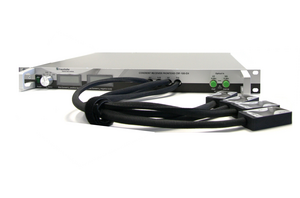The Fraunhofer Heinrich Hertz Institute HHI developed a high-performance stand-alone coherent receiver frontend based on high-speed balanced photodetectors, with an electrical 3-dB bandwidth of 100 GHz requiring no digital signal processing assistance. Uniquely equipped with optical extender heads, the frontend maintains high signal integrity up to 100 GHz. It provides state-of-the-art testing and measurement capabilities, and enables to detect polarization- and phase-diverse high-speed optical signals carrying more than 1 Tbit/s per single wavelength.
The rapid growth in bandwidth demand due to the immense increase in the number of subscribers/devices and download speeds coupled with emerging bandwidth-hungry applications, such as high-definition video-on-demand (NetFlix, YouTube, etc), cloud computing/storage (Big Data), and machine learning/artificial Intelligence, are putting significant pressure on today’s communication networks. To meet this demand in an economical and power-efficient manner, and to support future connectivity, it is crucial to develop high-bandwidth components and sub-systems enabling ultra-high-speed transmission systems. A critical requirement for such developments is the availability of high-speed test & measurement equipment offering performance well ahead of today’s state-of-the-art optical telecommunication products.
Researchers at Fraunhofer HHI developed a 100 GHz Coherent Receiver optical Frontend (CRF‑100G), operating in the telecommunication C+L-band. The meticulously designed and optimized CRF-100G provides 100 GHz (hardware) detection bandwidth offering polarization- and phase-diversity. It features ultimate performance for test and measurement purposes in cutting-edge research and development activities for next-generation optical fiber transmission networks. The frontend comes in a compact 19’’-chassis. Owing to its customizable four optical extender heads, it provides a direct and vendor-independent connection to third-party test and measurement equipment, e.g., high-bandwidth real-time oscilloscopes. Dr. Sezer Erkılınç, senior researcher at Fraunhofer HHI’s Photonic Networks and Systems Department and responsible for the coherent frontend development, explains: "A high signal integrity is crucial whilst operating at such high electrical bandwidths. However, RF electrical cables used for connecting a coherent frontend to an oscilloscope induce significant attenuation and distort the signal. Thus, in our development, so-called CRF-100G, we designed optical heads that extend the optical signal and allow direct connection to high bandwidth scopes so that the signal quality is preserved, achieving the highest possible performance.” The successful operation of the CRF-100G was verified in a demonstration of 2.3 Tb/s super-channel joint detection (3 x 64 GBaud 64-QAM).
The CRF-100G is the latest of a number of high performance test & measurement prototypes for digital coherent communication systems, developed by Fraunhofer HHI researchers. Digital coherent technologies have revolutionized the way telecommunication links are designed and recently became the well-established technology for high capacity optical networks. “Our prototypes help researchers in their highly innovative system research and development activities, such as future data-center applications targeting 0.8 and 1.6 Tb/s”, adds Dr. Colja Schubert, head of Fraunhofer HHI’s Submarine & Core Systems group.
Details of the CRF-100G and other high performance test & measurement prototypes will be presented at the International Symposium on Ultrafast Photonic Technologies & Special Symposium on Silicon Photonics of the Future (ISUPT/SSPhF) in Napa, California in June 2019 and at the exhibition of the 45th European Conference on Optical Communication (ECOC) taking place in Dublin, Ireland in September 2019.
